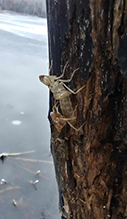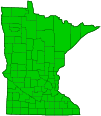dragonflies
(Suborder Anisoptera)
Overview • Description • Distribution • Taxonomy
Dragonflies occur worldwide on every continent except Antarctica. They have been recorded in every county in Minnesota. Dragonfly adults are predatory. They feed on a wide variety of flying insects, including mosquitoes, flies, butterflies, moths, and smaller dragonflies. They only eat living insects, and they almost always capture them in flight. Dragonfly young, known as naiads, are aquatic. They feed on any living thing that moves through the water, including aquatic larvae of mosquitoes and flies, other dragonfly naiads, tadpoles, and small fish. Dragonfly adults do not survive the winter. With most species, the naiads spend northern winters in water under ice in a state of suspended animation called diapause. With some species, the females lay their eggs on a shore, where they are washed into the water in the following spring. |
||
Description |
||
Dragonflies are large flying insects. The flight is agile, strong, and sustained. The head is bulbous, nearly as long as wide. The back of the head is hollowed out. The compound eyes are extremely large and fill most of the head. They meet at the top of the head in all species except clubtails. There are three small simple eyes (ocelli) in a triangle on top of the head. The antennae are minute. The lower lip (labrum) has a middle lobe and two strongly toothed lateral lobes. This is the feature that gives the infraorder its name. The word Anisoptera is Latin for “toothed ones”. The abdomen is slender and has ten segments. On the female of most species, there is a subgenital plate on the underside of segment 8, but on some species, there is a needle-like, egg-laying apparatus (ovipositor) there. At the end of segment 10 there are three appendages. On the male, these function as claspers and are used to grab and hold the female during mating. There are two pairs of transparent, membranous wings with many small veins. They are held flat and away from the body when at rest. The hindwings are larger and have a different shape than the forewings. On the leading edge (costal margin) of each wing, there is a node (nodus) near the middle. The nodus allows the wing to flex downward but not upward during flight. Near the wingtip on the costal margin there is a thick, opaque, blood-filled cell (stigma). The stigma is thought to dampen vibrations when in flight. Unlike most winged insects, dragonfly wings are attached directly to the flight muscles, not to chitinous plates of the exoskeleton. The legs are spiny. On the front legs of the male, one row of spines is modified into a brush that the male uses to clean its eyes. |
||
Distribution |
||||
|
Sources Haarstad, J. 1997. The dragonflies of selected eastern Minnesota rivers. Report submitted to the Minnesota Department of Natural Resources. Unpaged. |
|||
| 1/14/2023 | ||||
Taxonomy |
|||
Order |
Odonata (dragonflies and damselflies) | ||
Subordinate Taxa |
|||
Superfamily Aeshnoidea Family Aeshnidae (darners) Family Austropetaliidae (redspots) Superfamily Cordulegastroidea Family Chlorogomphidae Family Cordulegastridae (spiketails) Family Neopetaliidae (spotwings) Superfamily Gomphoidea Family Gomphidae (clubtails) Superfamily Libelluloidea Family Corduliidae (emeralds) Family Libellulidae (skimmers) Family Macromiidae (cruisers) Family Synthemistidae (tigertails) Superfamily Petaluroidea Family Petaluridae (petaltails) |
|||
Synonyms |
|||
|
|||
Common Names |
|||
dragonflies |
|||
Glossary
Costal margin
The leading edge of the forewing of insects.
Naiad
The aquatic larval form (nymph) of a dragonfly, mayfly, or stonefly.
Nodus
On dragonflies and damselflies: the small notch on the lead edge of each wing about halfway between the body and the tip.
Ocellus
Simple eye; an eye with a single lens. Plural: ocelli.
Ovipositor
A tube-like organ near the end of the abdomen of many female insects, used to prepare a place for an egg and to place the egg.
Stigma
In plants, the portion of the female part of the flower that is receptive to pollen. In Lepidoptera, an area of specialized scent scales on the forewing of some skippers, hairstreaks, and moths. In other insects, a thickened, dark, or opaque cell on the leading edge of the wing.
Subgenital plate
In male Orthoptera, the plate-like structure extending from the lower (ventral) side of the end of the abdomen underlying the genitalia.
Visitor Photos |
|||||
Share your photo of this insect. |
|||||
| This button not working for you? Simply email us at info@MinnesotaSeasons.com. Attach one or more photos and, if you like, a caption. |
|||||
Luciearl |
|||||
It was on a tree that was in the water (ice). |
|||||
 |
|||||
MinnesotaSeasons.com Photos |
|||||
|
|||||

Slideshows |
||

Visitor Videos |
|||
Share your video of this insect. |
|||
| This button not working for you? Simply email us at info@MinnesotaSeasons.com. Attach a video, a YouTube link, or a cloud storage link. |
|||
Other Videos |
|||
| Dragonfly (Anisoptera) [HD] Nature and Animal Finder |
|||
About
Nov 3, 2022 A dragonfly is a flying insect belonging to the order Odonata, Suborder Anisoptera. About 3,000 extant species of true dragonfly are known. Most are tropical, with fewer species in temperate regions. Loss of wetland habitat threatens dragonfly populations around the world. Adult dragonflies are characterized by a pair of large, multifaceted compound eyes, two pairs of strong, transparent wings, sometimes with coloured patches, and an elongated body. Many adult dragonflies have brilliant iridescent or metallic colours produced by structural colouration, making them conspicuous in flight. Their overall coloration is often a combination of yellow, red, brown, and black pigments, with structural colours. The sex ratio of male to female dragonflies varies both temporally and spatially. Adult dragonflies have a high male-biased ratio at breeding habitats. |
|||
| Dragonfly Insect Animal - Anisoptera BacktoNature |
|||
About
Mar 8, 2019 Dragonfly Insect Animal - Anisoptera Dragonfly Scientific Name: Anisoptera |
|||
| Dragonfly Insect Anisoptera walpar |
|||
About
May 28, 2009 Video of a Brown Dragonfly, type undetermined. This is the fastest flying insect. When he takes off at the end of the video, look quick to see him go. |
|||

Created: 1/14/2024
Last Updated:


